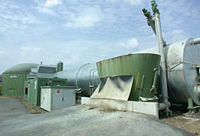
Photo from wikipedia
Heat preconditioning (HP) is a powerful adaptive and protective phenomenon and induces moderation of diabetic alterations in glycogen metabolism of rats. Aspirin (acetylsalicylic acid, ASA), as a multifunctional drug has… Click to show full abstract
Heat preconditioning (HP) is a powerful adaptive and protective phenomenon and induces moderation of diabetic alterations in glycogen metabolism of rats. Aspirin (acetylsalicylic acid, ASA), as a multifunctional drug has also been reported to exert hypoglycemic effects in the treatment of diabetes. We estimated the effect of HP (45 min/41 ± 0.5 °C/24 h recovery) and single dose aspirin (100 mg/kg b.w./i.p) treatment over carbohydrate-related enzymes and substrates in a time-dependent (2, 7 and 14 days) manner of duration of diabetes in the liver of rats. Heat preconditioning resulted in lower liver glucose concentration, but higher HK activity and lower G6P-ase; very evident and significantly higher glycogen content and GPho-ase activity, as well as very evident and significantly lower F1,6BP-ase and higher PFK activity compared to control diabetic animals. Aspirin pretreatment of HP-diabetic animals is manifested with significantly lower blood and liver glucose, higher G6P concentration, lower G6P-ase and HK activity as well as higher Glk content and GPho-ase activity, compared both to diabetic and HP-diabetic animals. In conclusion, both HP and aspirin, as physiological and pharmacological inductors of HSP70, respectively, attenuate the carbohydrate-related disturbances in diabetic rats, with almost tendency to normalisation to the control values for most of the estimated parameters.
Journal Title: Journal of thermal biology
Year Published: 2019
Link to full text (if available)
Share on Social Media: Sign Up to like & get
recommendations!